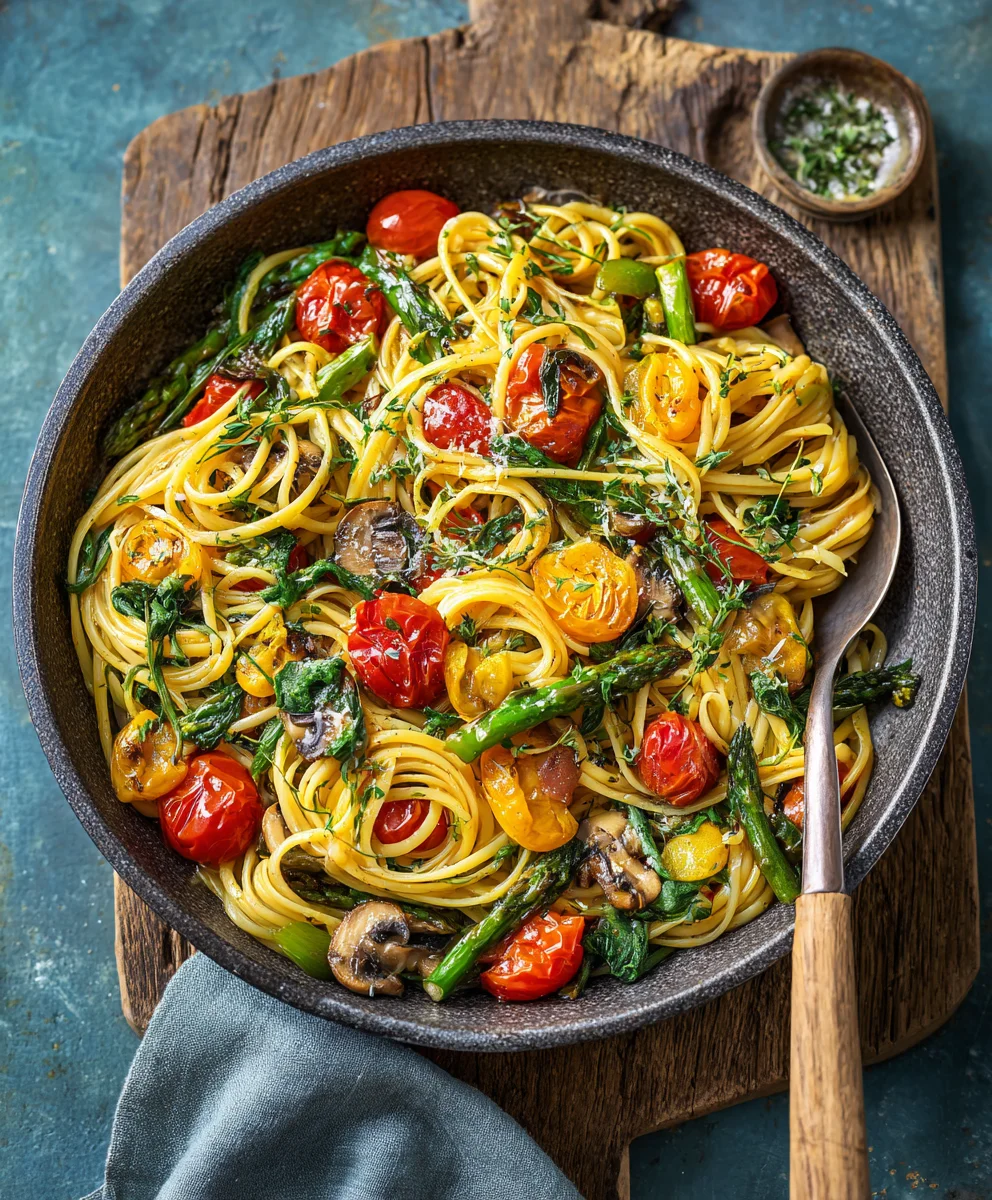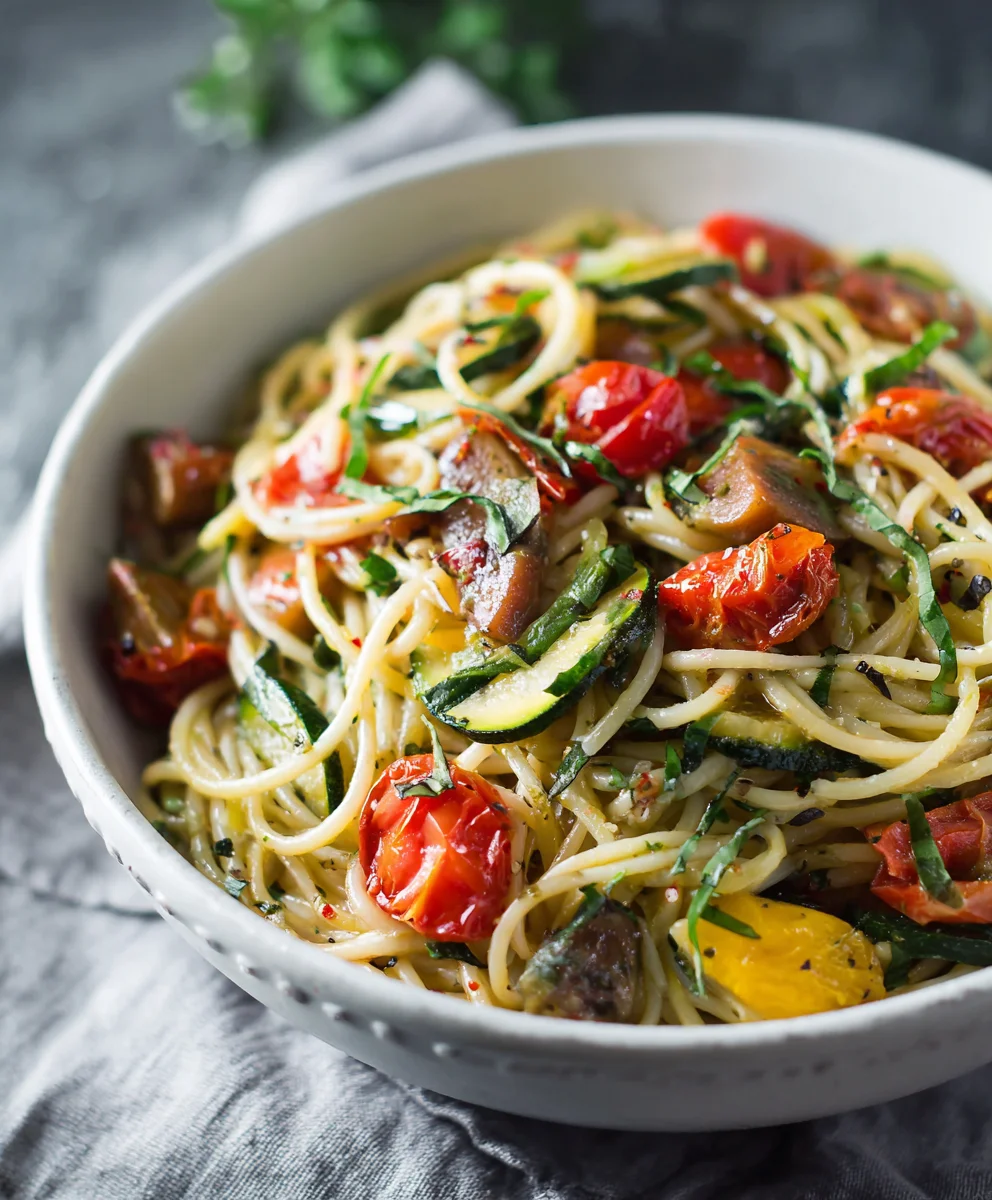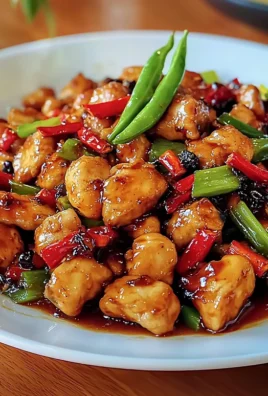Summer Garden Pasta is more than just a meal; it’s a vibrant ode to the warmer months, capturing the very essence of sun-drenched flavors in every forkful. I am absolutely thrilled to share with you a recipe that promises to transform your kitchen into a haven of fresh aromas and delightful tastes. Imagine the peak ripeness of garden tomatoes, the aromatic whisper of fresh basil, and the subtle warmth of garlic, all harmoniously tossed with al dente pasta. This dish isn’t just food; it’s a culinary embrace of summer’s generous bounty.
While the concept of simply combining fresh produce with pasta has roots in various regional Italian traditions, this particular rendition, the celebrated Summer Garden Pasta, has become a beloved modern classic. Its widespread appeal stems from its brilliant simplicity and its commitment to showcasing seasonal ingredients at their finest. There’s no heavy sauce to mask the flavors, just pure, unadulterated freshness that speaks for itself.
People genuinely adore this dish for so many reasons. Its light yet satisfying character makes it an ideal choice for a quick weeknight dinner, a refreshing lunch, or a delightful addition to any gathering. It’s incredibly versatile, naturally accommodating various dietary preferences, and delivers an explosion of bright, zesty flavors that leave you feeling nourished and uplifted. Join me as we embark on crafting this truly exceptional pasta dish that celebrates the joy of eating fresh.
Ingredients:
- 1 pound (450g) good quality pasta: I love using a short, robust pasta like orecchiette, penne, or fusilli for this Summer Garden Pasta, as their nooks and crannies really hold onto the delicious sauce. Feel free to use your favorite!
- 2 pounds (approx. 6-8 medium) ripe tomatoes: A mix of varieties like Roma, cherry, grape, or even heirloom tomatoes will add wonderful depth and color. Freshness is key here for the best Summer Garden Pasta experience.
- 1 large English cucumber: Or 2-3 smaller Persian cucumbers, peeled and deseeded if necessary, offering a refreshing crunch.
- 1 medium red onion: Finely diced, for a gentle bite and beautiful color contrast.
- 2-3 cloves garlic: Freshly minced, because you can never have too much garlic in a vibrant pasta dish.
- 1/2 cup (120ml) extra virgin olive oil: A high-quality oil will elevate all the fresh flavors of your Summer Garden Pasta.
- 1/4 cup (60ml) red wine vinegar: Or white wine vinegar, to add a bright, acidic lift.
- 1/4 cup (60ml) fresh basil leaves: Finely chopped, plus extra whole leaves for garnish. This is essential for that quintessential “Summer Garden” aroma.
- 1/4 cup (60ml) fresh parsley: Finely chopped, adding another layer of herbaceous freshness.
- 1/2 cup (120ml) crumbled feta cheese: Or fresh mozzarella balls (bocconcini), halved. The creamy, salty notes are a perfect complement.
- Salt and freshly ground black pepper: To taste, but don’t be shy! These bring out all the beautiful flavors.
- Optional additions:
- 1/4 cup Kalamata olives: Pitted and halved, for a briny Mediterranean twist.
- 1/2 cup grilled corn kernels: Sliced fresh off the cob, for a touch of sweetness and smoky flavor.
- 1/2 cup roasted bell peppers: Diced (red or yellow work wonderfully), adding another layer of sweetness and color.
Preparing Your Fresh Garden Bounty
- Tackling the Tomatoes: This is where the magic for our Summer Garden Pasta truly begins! First, gather all your beautiful, ripe tomatoes. I like to give them a good wash under cool running water. For a chunkier, more rustic sauce, you can simply dice them. However, for a smoother texture and to remove any bitterness from the skins, I highly recommend blanching them. To do this, carefully make a small “X” incision on the bottom of each tomato. Bring a medium pot of water to a rolling boil. Gently drop the tomatoes into the boiling water for about 30-60 seconds, just until you see the skins start to peel back at the “X.” Immediately transfer them using a slotted spoon into a large bowl of ice water. This sudden temperature change, known as shocking, stops the cooking process and makes the skins incredibly easy to remove. Once cooled, peel the skins with your fingers – they should slip right off! Then, quarter each tomato, remove the core, and gently squeeze out most of the seeds and excess liquid. This prevents your sauce from becoming watery. Finally, dice the peeled and deseeded tomato flesh into roughly 1/2-inch pieces. Place all the diced tomatoes into a large, non-reactive bowl – this will be the home for our incredible sauce.
- Preparing the Refreshing Cucumber: Our Summer Garden Pasta thrives on fresh, crisp textures. Take your English cucumber (or Persian cucumbers). Wash it thoroughly. For English cucumbers, I usually don’t bother peeling unless the skin feels particularly tough. For Persian cucumbers, the skin is tender enough to leave on. Slice the cucumber lengthwise and use a spoon to scoop out the watery seeds. This step is crucial because it prevents your pasta salad from becoming soggy later on. Once deseeded, dice the cucumber into similar 1/2-inch pieces, matching the size of your tomatoes. Add these beautifully diced cucumbers to the bowl with your prepared tomatoes. The vibrant green will already start to pop!
- Mincing the Aromatics: These ingredients are the backbone of flavor for any great Summer Garden Pasta. Start with your red onion. Peel off the outer layer and finely dice the onion. You want small, consistent pieces that distribute flavor evenly without overwhelming the other ingredients. If you find red onion too pungent, a little trick is to rinse the diced onion under cold water for a minute or two and then pat it very dry; this helps to mellow its sharp edge. Next, grab your garlic cloves. Peel them and then mince them as finely as you possibly can. I find using a garlic press works wonders here, ensuring every bit of garlicky goodness is released. Add the diced red onion and minced garlic to the bowl with your tomatoes and cucumbers. The aromas are already starting to build!
- Herbal Harmony: Fresh herbs are non-negotiable for a truly authentic Summer Garden Pasta. Wash your fresh basil and parsley under cold water and gently pat them completely dry with a paper towel or a clean kitchen towel. Stacking the basil leaves and rolling them into a tight cylinder before thinly slicing (a technique called chiffonade) makes for beautiful, delicate ribbons. For the parsley, simply chop it finely. We’re aiming for about 1/4 cup of each, but honestly, feel free to add a little more if you’re an herb lover like I am! Add the chopped basil and parsley to the large bowl with all the other vegetables. The bowl should now be bursting with color and promise.
- Adding Optional Goodies (if using): If you’ve decided to include any of the optional ingredients like pitted Kalamata olives, grilled corn, or roasted bell peppers, now is the time to prepare and add them. If using olives, make sure they are pitted and then halve them. For grilled corn, simply slice the kernels off the cob. If using roasted bell peppers, dice them to a similar size as your tomatoes and cucumbers. These additions can truly personalize your Summer Garden Pasta, adding extra layers of flavor and texture. Add them to the growing collection of fresh ingredients in your large bowl.
Crafting the Aromatic Sauce Base
- Building the Dressing: This is where we bring everything together into a cohesive, flavorful experience for our Summer Garden Pasta. To the large bowl containing all your prepared vegetables and herbs, pour in your generous 1/2 cup of high-quality extra virgin olive oil. Don’t skimp here; the oil acts as a carrier for all the fat-soluble flavors and adds a beautiful richness. Next, add the 1/4 cup of red wine vinegar. This provides the crucial acidic component that brightens the entire dish and balances the richness of the oil and the sweetness of the tomatoes. Now, let’s talk seasoning: sprinkle in a good pinch of salt and a generous grind of fresh black pepper. I usually start with about 1 teaspoon of salt and 1/2 teaspoon of pepper, but remember, you’ll adjust this later to your personal preference.
- The Gentle Mix and Mellowing Process: With all the dressing components in the bowl, grab a large spoon or spatula and gently toss everything together until all the vegetables are beautifully coated. Be sure to mix from the bottom up to ensure the garlic and herbs are evenly distributed. Once mixed, this is a crucial step for the best Summer Garden Pasta: cover the bowl with plastic wrap and let it sit at room temperature for at least 30 minutes, or even better, for 1-2 hours. If your kitchen is very warm, you can refrigerate it, but bring it back to room temperature before serving. During this waiting period, the flavors will meld and marry beautifully. The salt will draw out some liquid from the vegetables, creating a natural, vibrant “sauce,” and the garlic and herbs will infuse the oil and vinegar, making every bite burst with flavor. This resting time is what truly transforms individual ingredients into a harmonious Summer Garden Pasta experience. Trust me, it’s worth the wait!
Cooking the Perfect Pasta
- Boiling the Water for Success: While your vegetable mixture is marinating and developing its incredible flavors, you can start on the pasta. Choose a large pot, one that can comfortably hold at least 4-6 quarts of water for every pound of pasta. Fill it about two-thirds full with cold water. Now, and this is perhaps one of the most important tips for any pasta dish, add a generous amount of salt to the water. I mean, really generous – it should taste like the ocean! We’re talking 1 to 2 tablespoons of kosher salt per gallon of water. This is your only chance to season the pasta itself from the inside out, making sure every strand is flavorful. Bring this well-salted water to a rolling, vigorous boil over high heat. Don’t add the pasta until the water is bubbling intensely.
- Cooking the Pasta to Perfection: Once your water is at a furious boil, carefully add your pound of chosen pasta. Stir it immediately to prevent the pasta from sticking together, especially during the first minute or two. Keep stirring occasionally throughout the cooking process. Cook the pasta according to the package directions until it reaches the coveted al dente stage. This means it should be tender but still have a slight bite or firmness in the center, not mushy. I usually start tasting a minute or two before the suggested cooking time to ensure I hit that perfect texture. For our Summer Garden Pasta, an al dente texture is vital because it will absorb some of the dressing without becoming soft or limp.
- Draining and Saving Pasta Water: Before you drain the pasta, and this is another crucial pro-tip, reach into the pot with a heat-proof measuring cup and reserve about 1 cup of that starchy pasta cooking water. This liquid is liquid gold! It’s full of starch, which will help emulsify our sauce and give it a silky texture, especially if the Summer Garden Pasta feels a bit dry later on. After saving the water, drain the cooked pasta thoroughly in a colander. Do NOT rinse the pasta under cold water! Rinsing removes the starches that help the sauce cling to the pasta, which we absolutely want for our Summer Garden Pasta. Immediately transfer the hot, drained pasta into the large bowl with your marinated vegetable mixture. The residual heat from the pasta will gently warm the vegetables, intensifying their flavors even further.
Bringing It All Together: Assembling Your Summer Garden Pasta
- Combining Pasta and Sauce: With the hot pasta now in the bowl with your beautifully marinated vegetables, it’s time to bring our Summer Garden Pasta masterpiece to life. Use tongs or two large spoons to gently, yet thoroughly, toss the pasta with the vegetable mixture. Ensure every piece of pasta is coated in that vibrant, aromatic dressing. You’ll notice the steam from the pasta warming the herbs and garlic, releasing even more incredible aromas. This process allows the pasta to absorb some of the delicious juices and olive oil, creating a truly harmonious dish.
- Incorporating the Feta (or Mozzarella): Once the pasta and vegetables are well combined, it’s time to add the cheese. Sprinkle in the 1/2 cup of crumbled feta cheese or your halved fresh mozzarella balls. Gently toss again, just enough to distribute the cheese throughout the Summer Garden Pasta without breaking it up too much. The salty, tangy notes of the feta or the creamy richness of the mozzarella add another wonderful layer of flavor and texture that complements the fresh vegetables perfectly.
- The All-Important Taste Test and Adjustment: This is a step you should never skip! Taste a forkful of your Summer Garden Pasta. How are the flavors? Does it need more salt? More pepper? Perhaps a splash more red wine vinegar for brightness? Or maybe a tiny drizzle more olive oil for richness? If the pasta seems a little dry or the sauce isn’t as luxurious as you’d like, now is the time to add a tablespoon or two of that reserved pasta water. Stir it in gradually; the starch will help to create a slightly thicker, more cohesive sauce that clings beautifully to the pasta. Adjust seasoning to your personal preference until it sings! This careful adjustment is what takes your Summer Garden Pasta from good to absolutely unforgettable.
Serving Suggestions and Finishing Touches
- A Moment of Rest (Optional, but Recommended): While you can absolutely serve this Summer Garden Pasta immediately, I often find that letting it rest for another 10-15 minutes at room temperature allows the flavors to truly deepen and meld even further. The pasta continues to absorb the dressing, becoming even more flavorful. This is a great time to set the table or prepare any accompanying dishes.
- The Grand Presentation: Transfer your glorious Summer Garden Pasta to a large serving bowl. For a final flourish, garnish generously with a few extra fresh basil leaves, perhaps torn or whole, and another light grind of fresh black pepper. A final drizzle of your best extra virgin olive oil over the top just before serving adds a beautiful sheen and highlights the freshness.
- Serving and Enjoying Your Creation: This Summer Garden Pasta is truly best served at room temperature, allowing all the fresh flavors to shine through beautifully. It makes an excellent light main course on a warm evening or a fantastic side dish for grilled chicken, fish, or a robust steak. It’s also superb for picnics, potlucks, or any gathering where fresh, vibrant food is appreciated. Leftovers, if you have any, are wonderful for lunch the next day, though the cucumbers might soften slightly. Enjoy every single bite of this quintessential taste of summer!

Conclusion:
So, there you have it! We’ve journeyed through the simple steps to create a truly unforgettable dish. This isn’t just another pasta recipe; it’s a celebration of fresh, vibrant ingredients coming together in perfect harmony. What makes it a must-try, you ask? Well, first and foremost, it’s the incredible burst of flavor you get from every single bite. The sweetness of ripe tomatoes, the aromatic basil, the pungent garlic – all coalesce into a taste sensation that’s both comforting and invigorating. It’s light enough for a warm evening yet satisfying enough to be a complete meal. I truly believe that once you experience the ease of preparation combined with the profound deliciousness, this recipe will quickly become a cherished favorite in your culinary repertoire.
Beyond its fantastic taste, the simplicity of this dish is a major win. No complex techniques, no hours slaving over a hot stove – just straightforward, honest cooking that yields spectacular results. It’s perfect for those busy weeknights when you want something homemade and wholesome but are short on time. It also shines as a fantastic option for entertaining; it looks impressive, tastes divine, and allows you to spend more time with your guests and less time fussing in the kitchen. The freshness factor is simply unparalleled, especially when you use peak-season produce. It’s food that makes you feel good from the inside out, nourishing both body and soul with its clean flavors and wholesome ingredients.
Now, let’s talk about making this recipe truly your own! While it’s utterly fantastic as a standalone dish, there are countless ways to customize it and make it fit any occasion or preference. For serving, I absolutely adore it served warm, allowing the heat to gently coax out all the wonderful aromas and meld the flavors together. However, don’t shy away from trying it chilled or at room temperature, especially on a sweltering summer day. It transforms into a refreshing pasta salad that’s ideal for picnics, potlucks, or a light lunch. Imagine a vibrant bowl of this at your next backyard barbecue! It’s incredibly versatile.
Thinking about variations, the sky’s the limit! If you’re looking to add some protein, grilled chicken or shrimp would be an absolutely exquisite addition, offering a heartier meal without overpowering the delicate flavors. For my vegetarian friends seeking extra protein, white beans or chickpeas would be fantastic, adding a creamy texture and nutty flavor. A sprinkle of toasted pine nuts or walnuts could also introduce a lovely crunch. And cheese! Oh, the cheese possibilities! While fresh Parmesan or Pecorino Romano is a classic choice, don’t hesitate to experiment with crumbled fresh mozzarella, creamy dollops of burrata, or even a sprinkle of goat cheese for a tangy counterpoint. Each will bring its own unique character to the dish.
Don’t stop there with the vegetables, either. Feel free to toss in some sautéed zucchini, bell peppers of various colors, or even some fresh spinach or arugula at the very end to wilt slightly in the warmth of the pasta. A squeeze of fresh lemon juice right before serving can brighten everything up even further, adding a zesty zing. And for those who enjoy a bit of heat, a pinch of red pepper flakes can provide a wonderful kick. If you’re catering to dietary restrictions, this recipe is remarkably adaptable. For a gluten-free version, simply use your favorite gluten-free pasta. For a completely vegan meal, omit the cheese entirely, or use a high-quality plant-based Parmesan alternative – the abundance of fresh vegetables and herbs ensures it will still be incredibly flavorful and satisfying. This is your canvas, so paint with your favorite flavors!
So, what are you waiting for? I genuinely hope that reading through this has inspired you to roll up your sleeves and bring this fantastic recipe to life in your own kitchen. There’s an immense joy in creating something delicious from scratch, especially when it involves such beautiful, fresh ingredients. I promise you, the effort is minimal, and the reward is truly magnificent. This Summer Garden Pasta is more than just a meal; it’s an experience – a delightful journey for your taste buds that captures the essence of fresh produce and simple, honest cooking. It truly embodies everything I love about vibrant, comforting food.
I am so excited for you to try this, and I can’t wait to hear all about your culinary adventures. Once you’ve whipped up your own batch of this delightful pasta, please do come back and share your thoughts. What variations did you try? Who did you share it with? Did you serve it warm or cold? Your insights and experiences are invaluable, not just to me, but to our entire community of food lovers. Sharing your triumphs and even your little experiments helps us all grow and discover new ways to enjoy food. Let’s celebrate the art of cooking together!
Thank you for joining me on this delicious journey. Happy cooking, and I look forward to hearing about your incredibly flavorful creations!

Vibrant Summer Garden Pasta
A vibrant ode to warmer months, capturing the essence of sun-drenched flavors in every forkful. This dish is a culinary embrace of summer’s generous bounty, showcasing peak ripeness of garden tomatoes, fresh basil, and garlic with al dente pasta.
Ingredients
-
1 pound (450g) pasta (e.g., orecchiette, penne, fusilli)
-
2 pounds ripe tomatoes (e.g., Roma, cherry, grape)
-
1 large English cucumber (or 2-3 smaller Persian)
-
1 medium red onion, finely diced
-
2-3 cloves garlic, minced
-
1/2 cup (120ml) extra virgin olive oil
-
1/4 cup (60ml) apple cider vinegar (non-alcoholic alternative)
-
1/4 cup (60ml) fresh basil, chopped (plus extra for garnish)
-
1/4 cup (60ml) fresh parsley, chopped
-
1/2 cup (120ml) crumbled feta cheese (or fresh mozzarella balls, halved)
-
Salt and freshly ground black pepper, to taste
-
Optional: 1/4 cup Kalamata olives, pitted and halved
-
Optional: 1/2 cup grilled corn kernels
-
Optional: 1/2 cup roasted bell peppers, diced
Instructions
-
Step 1
For tomatoes: wash, blanch briefly (30-60s), shock in ice water, peel, core, deseed, and dice into 1/2-inch pieces. For cucumber: wash, deseed, and dice into 1/2-inch pieces. Finely dice red onion and mince garlic. Wash, dry, and finely chop basil and parsley. Combine all prepared vegetables and herbs in a large bowl. Add any optional ingredients (olives, corn, bell peppers) if using. -
Step 2
To the bowl of prepared vegetables, add 1/2 cup extra virgin olive oil, 1/4 cup apple cider vinegar, salt, and pepper. Gently toss to coat. Cover the bowl and let the mixture marinate at room temperature for at least 30 minutes, or up to 2 hours, allowing flavors to meld. -
Step 3
While vegetables marinate, cook pasta. Bring a large pot of heavily salted water to a rolling boil. Add 1 lb pasta and cook according to package directions until al dente. Before draining, reserve 1 cup of starchy pasta water. Drain the pasta (do not rinse) and immediately transfer it to the bowl with the marinated vegetable mixture. -
Step 4
Toss the hot pasta with the marinated vegetables until well combined. Add 1/2 cup crumbled feta (or mozzarella) and gently toss again. Taste and adjust seasoning with salt, pepper, or a splash more vinegar/oil as needed. If the dish seems dry, add a tablespoon or two of the reserved pasta water to create a luscious sauce. -
Step 5
For best flavor, let the pasta rest for 10-15 minutes at room temperature before serving. Transfer to a serving bowl, garnish with fresh basil and a drizzle of olive oil. Serve at room temperature as a main course or side dish.
Important Information
Nutrition Facts (Per Serving)
It is important to consider this information as approximate and not to use it as definitive health advice.
Allergy Information
Please check ingredients for potential allergens and consult a health professional if in doubt.





Leave a Comment